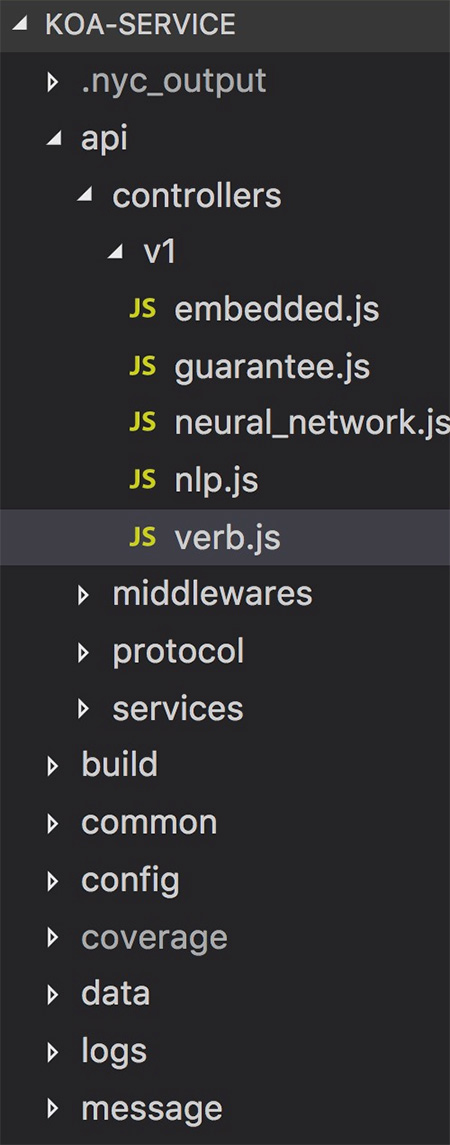代码地址如下:<br>http://www.demodashi.com/demo/12932.html
一、简介
koa是由Express原班人马打造的,致力于成为一个更小、更富有表现力、更健壮的Web框架,Koa不定制路由,无冗余的中间件,开发设计方案趋向定制化,所以很适合对业务和技术有灵活要求的web场景。
二、应用
由于restful、加解密、跨域、参数解析、中间件等比较基础,且文档丰富,本小节将直接跳过,侧重于分享以下几点:
1、路由转发时,如何利用钩子函数机制做到controller层业务解耦
2、在socket通信中如何动态加载protobuf进行数据格式交换
3、如何基于websocket绑定相同的端口
4、如何利用c++编写node扩展库
- 2.1 业务解耦
中间件及钩子函数机制皆为业务解耦的有效实现方式,其中中间件模式因其实现方便而应用广泛, 如koa、express、sails中都曾大量用到, 而钩子函数机制在node生态中被大量用到ORM对数据库的操作,如mongoose、waterline,鲜有在controller层的广泛应用,本小节则尝试分享 一个简易的Hooks实现方式,并应用在koa框架中。
编写koa-hooks, 并提交到npm
const hooks = require('hooks')
class ApiHooks {
constructor(ctx, next, cb) {
this._ctx = ctx
this._next = next
this._cb = cb
this._listenerTree = {}
this.addListenerTree()
}
addListenerTree() {
for (let fn in hooks) {
this[fn] = hooks[fn]
}
}
addHooks(listeners) {
const self = this
try {
listeners.map(listener => {
const [method, hooksFn] = listener.split('.')
if(hooksFn.match('before')) self.addFn(method, hooksFn, 'pre')
if(hooksFn.match('after')) self.addFn(method, hooksFn, 'post')
})
} catch (err) {
console.log('err:', err)
}
}
addFn(method, hooksFn, hook) {
const self = this
self[hook](method, async (next) => {
await self[hooksFn](self._ctx, next, self._cb)
})
}
}
module.exports = ApiHooks
编写一个restful风格接口/v1/verb/get,继承ApiHooks, 添加对应的钩子函数beforeVerbCheckLogin实现登录检查
/**
* Created by Joseph on 18/09/2017.
*/
const Api = require('koa-hooks').Api
const VerbService = require('../../services/verb.js')
class VerbApi extends Api {
constructor(ctx, next, cb) {
super(ctx, next, cb)
this.addHooks([
'verbGetOnThisRequest.beforeVerbCheckLogin',
'verbPostOnThisRequest.beforeVerbCheckLogin',
'verbPutOnThisRequest.beforeVerbCheckLogin',
'verbDeleteOnThisRequest.beforeVerbCheckLogin',
])
}
async beforeVerbCheckLogin(ctx, next, cb) {
const data = await VerbService.beforeVerbCheckLogin(ctx, next)
data ? cb(ctx, data) : await next()
}
async verbGetOnThisRequest(ctx, next, cb) {
const data = await VerbService.verbGetOnThisTest(ctx, next)
data ? cb(ctx, data) : await next()
}
async verbPostOnThisRequest(ctx, next, cb) {
const data = await VerbService.verbPostOnThisTest(ctx, next)
data ? cb(ctx, data) : await next()
}
async verbPutOnThisRequest(ctx, next, cb) {
const data = await VerbService.verbPutOnThisTest(ctx, next)
data ? cb(ctx, data) : await next()
}
async verbDeleteOnThisRequest(ctx, next, cb) {
const data = await VerbService.verbDeleteOnThisTest(ctx, next)
data ? cb(ctx, data) : await next()
}
}
module.exports = (ctx, next, cb) => new VerbApi(ctx, next, cb)
启动服务,请求接口http://127.0.0.1:3000/v1/verb/get,可以发现此钩子函数已经生效

注释掉//'verbGetOnThisRequest.beforeVerbCheckLogin', 再次请求接口,可以发现在需求变动情况对源码修改极少,代码可维护性提升

- 2.2 protobuf数据协议
protobuf是谷歌开源的是一种轻便高效的结构化数据存储格式, 且平台无关、语言无关、可扩展,通常用在tcp编程对数据传输要求较高的场 景,protobuf兼有json的可读性,且传输效率远大于json、xml等,非常适合流式数据交换。
A) 根据文件名及message动态加载protobuf
const protobuf = require('protobufjs')
const protoPath = '/Users/dreamboad/Projects/koa-service/message/'
class Proto {
async loadByName(protoName, messageName, obj, type) {
return new Promise((resolve, reject) => {
protobuf.load(`${protoPath}${protoName}.proto`, (err, root) => {
if (err) {
return console.log(err) || resolve()
}
const data = root.lookupType(`${protoName}.${messageName}`)
if (type === 'encode' && data.verify(obj)) {
return console.log('encode err') || resolve()
}
switch (type) {
case 'decode':
return resolve(data.toObject(data.decode(obj), { objects: true }))
case 'encode':
return resolve(data.encode(data.create(obj) || '').finish())
}
})
})
}
async deserialize(protoName, messageName, obj) {
return await this.loadByName(protoName, messageName, obj, 'decode')
}
async serialize(protoName, messageName, obj) {
return await this.loadByName(protoName, messageName, obj, 'encode')
}
}
module.exports = new Proto()
B) 编写soket client
/**
* 1、动态加载protobuf
* 2、socket数据流断包、粘包处理(TODO)
* 3、心跳机制、及断线重连
*/
const net = require('net')
const [HOST, PORT] = ['127.0.0.1', 9999]
const client = new net.Socket()
const connection = () => {
client.connect(PORT, HOST, () => { console.log('CONNECTED TO: ' + HOST + ':' + PORT)})
}
client.on('data', (data) => {
console.log(`${HOST}:${PORT} CONNECT DATA: `, data)
})
client.on('error', (e) => {
console.log(`${HOST}:${PORT} CONNECT ERROR: ` + e)
})
client.on('timeout', (e) => {
console.log(`${HOST}:${PORT} CONNECT TIMEOUT: ` + e)
})
client.on('end', (e) => {
console.log(`${HOST}:${PORT} CONNECT END: ` + e)
})
client.on('close', (e) => {
console.log(`${HOST}:${PORT} CONNECT CLOSE: ` + e)
if (client.destroyed) {
client.destroy()
}
setTimeout(connection, 3000)
})
process.on('exit', () => {
client.destroy()
client.on('close', () => {
console.log('Connection closed')
})
})
// 连接 客户端
module.exports = { connection, client }
C) 在soket通信中序列化/反序列化json数据
/**
* 序列化、反序列化
*/
const crypto = require('crypto')
const Proto = require('./protobuf')
class SocketProto {
async doTranslation(obj, protoName, messageName, operation) {
try {
switch (operation) {
case 'decode':
return await Proto.deserialize(obj, protoName, messageName)
case 'encode':
return await Proto.serialize(obj, protoName, messageName)
}
} catch (error) {
console.log(error)
}
}
async decode(obj, protoName, messageName) {
return await this.doTranslation(obj, protoName, messageName, 'decode')
}
async encode(obj, protoName, messageName) {
return await this.doTranslation(obj, protoName, messageName, 'encode')
}
}
module.exports = new SocketProto()
D) 连接服务器,读写流式数据,并用proto解析
const { connection, client } = require('./socket_client')
const SocketProto = require('./socket_protobuf')
const config = require('../config/').msgIdConfig
connection()
const writer = module.exports.writer = async (protoName, messageName, obj) => {
const w = await SocketProto.encode(protoName, messageName, obj)
return client.write(w)
}
const reader = module.exports.reader = async (protoName, messageName, obj) => {
const r = await SocketProto.decode(protoName, messageName, obj)
return r
}
client.on('data', (buf) => {
chooseFnByMsg('', 'basemsg', buf)
})
const chooseFnByMsg = (msgId, type, obj) => {
if (msgId) {
if (!config[msgId] || !config[msgId].req || !config[msgId].res) {
return console.log('noting to do: ', msgId)
}
}
switch (type) {
case 'basemsg':
return reader(config.head.res.pName, config.head.res.mName, obj)
case 'write':
return writer(config[msgId].req.pName, config[msgId].req.mName, obj)
case 'read':
return reader(config[msgId].res.pName, config[msgId].res.mName, obj)
default:
console.log('noting to do default: ', msgId)
break
}
}
chooseFnByMsg(1, 'write', { Field: "String" })
module.exports = chooseFnByMsg
E) server及client分别在终端打印结果


- 2.3 websocket
A) koa server
const app = new Koa()
// web socket
const server = require('http').Server(app.callback())
const io = require('socket.io')(server)
io.on('connection', client => {
console.log('new connection:')
client.on('news', (data, cb) => {
console.log('news:', data)
})
client.on('disconnect', () => {
console.log('disconnect:')
})
})
B) websocket client
const client = require('socket.io-client').connect('http://localhost:3000')
client.emit('news', "hello world")

- 2.1 C++插件
IO异步及高并发是Node的优势,但若在需要密集计算、集成基于C++的第三方SDK等场景时,Node的劣势则显现出来,此时可以基于node-gyp来嵌入集成C++解决以上等问题。
A) 安装node-gyp
cnpm install -g node-gyp
A) 编辑binding.gyp、C++、Node调用模块
{
"targets": [
{
"target_name": "demo",
"sources": ["src/demo.cc"]
},
{
"target_name": "test_params_nocb",
"sources": ["src/test_params_nocb.cc"]
},
{
"target_name": "test_function_nocb",
"sources": ["src/test_function_nocb.cc"]
},
{
"target_name": "test_params_function_nocb",
"sources": ["src/test_params_function_nocb.cc"]
}
]
}
// test_function_nocb.cc
#include <node.h>
namespace demo {
using v8::Function;
using v8::FunctionCallbackInfo;
using v8::Isolate;
using v8::Local;
using v8::Null;
using v8::Object;
using v8::String;
using v8::Value;
void RunCallback(const FunctionCallbackInfo<Value>& args) {
Isolate* isolate = args.GetIsolate();
Local<Function> cb = Local<Function>::Cast(args[0]);
Local<Value> argv[1] = { String::NewFromUtf8(isolate, "hello world") };
cb->Call(Null(isolate), 1, argv);
}
void Init(Local<Object> exports, Local<Object> module) {
NODE_SET_METHOD(module, "exports", RunCallback);
}
NODE_MODULE(test_function_nocb, Init)
} // namespace demo
module.exports.embeddedProxy = (cb, params) => {
return new Promise((resolve, reject) => {
try {
return cb((data) => { resolve(data) }, params)
} catch (err) {
return resolve({ data: "调用失败", code: -1 })
}
})
}
C) 编译C++
node-gyp configure
node-gyp build


D) 定义路由并调用接口

###项目文件目录结构截图 
三、参考
- 1、koa文档
- 2、protobufjs、npm
- 3、koa-hooks、npm
- 4、Node-gyp Node.js进阶篇-koa、钩子函数、websocket、嵌入式开发
代码地址如下:<br>http://www.demodashi.com/demo/12932.html
注:本文著作权归作者,由demo大师代发,拒绝转载,转载需要作者授权
来源:oschina
链接:https://my.oschina.net/u/4355030/blog/3875689